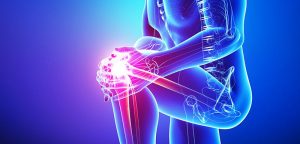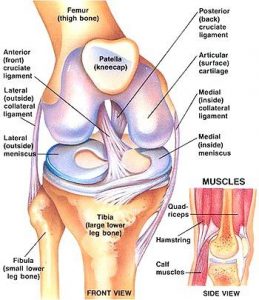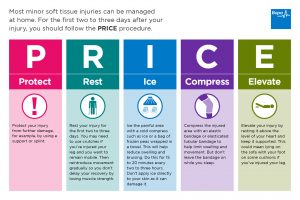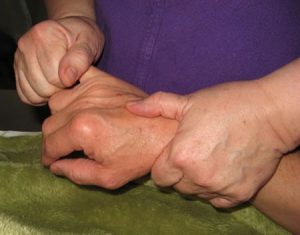Knee Pain Most Common Complaint
Knee pain is common. It’s the most common reason people see a doctor. It affects men and women of all ages. Injuries, overuse, arthritis, pain, swelling, stiffness, and limited range of motion all occur.
Sometimes you know exactly when / what happened. Other times it seems to come from out of nowhere.
Knee Anatomy

The knee is a complicated joint that not only holds us up it allows us to move. It hinges so we can sit, stand and walk. The knee also lets us twist and rotate.
How?…
It works in tandem with bones, ligaments, tendons, and cartilage.
In the lower leg, it is bound to the weight-bearing tibia. The kneecap or patella sits in front of the femur, (thighbone.)
It also connects to the non-weight bearing fibula (calf bone) attached by ligaments.
Four tough ligaments connect the bones together and allow for smooth movement.
Tendons connect the meniscus cartilage to bones. This cartilage lies along the top of the tibia and between the knobby protrusions of the femur bone. It provides cushioning between the bones.
There are also bursae…fluid-filled cushions. Three groups of these protectors take the impact from running and jumping.
Above the knee… the patellar ligament and quadriceps tendons allow the leg to straighten.
Pain Triggers
Knee pain can come from all sorts of triggers. A fall, twist or other injuries, overuse, or arthritis. It can also come from gout or an infection. Symptoms include pain, swelling, redness, stiffness and limited range of motion.
The pain can come from the knee, but also the hip, ankle or lower back.
Treating the Pain
The first step is to attempt to break the inflammation cycle.
PRICE:
- Protect – support the joint if needed. Stop activities that make it hurt.
- Rest – the knee needs rest to heal.
- Ice – several times daily.
- Compression – a compression bandage may help with swelling and offer support.
- Elevate – Get the knee up whenever possible. Use a footstool when sitting or a recliner.
Anti-inflammatories may also help – check with your doctor if you have other health issues.
Medically, they recommend trying the PRICE therapy for a week. If there is no improvement, you may need medical help. However, if the pain is severe, your knee won’t support you, you are running a fever…see a doctor.
Therapies include diagnostics to identify the problem. You may need x-rays, MRI or CAT scans, examination, etc. If a bone is dislocated, doctors can shift it back into place. Torn ligaments may need repair. Inflamed bursae may need to be drained.
A chiropractor may be able to do adjustments if the cause is an alignment issue. An LMT trained in the Berry techniques may be able to alleviate swelling and pain. They may be able to coax a ligament back into position. Rebalancing, stabilizing and relieving pain are the goals.
Minimize risk
To reduce the risks of knee pain, be aware of your body. Practice weight management. The heavier you are, the more strain it places on your joints and the more they may complain.
Move – walking is your friend. With proper supportive shoes, it is low impact. If your knees are problematic, consider swimming or water supported exercise. Keep limber, fit and build strength.
If you notice pain increasing when you are exercising – STOP. If you realize you’re tired – STOP. Protect your body and it will take good care of you.
LMT?
Are you a licensed massage therapist? Would you like to really help your clients with knee problems? Join me for an upcoming Knee Workshop, and I’ll share the Berry Techniques that I’ve used for 40 years. They relieve pain and help people get on with their lives. Check the class schedule for upcoming dates.
